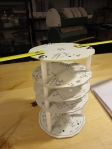The question 'what can you do with such a tiny satellite' has many answers. This week we're looking at Calliope's faster, cooler cousin, the ion-drive testing platform called FRETS1.
An ion engine in a satellite the size of a soda can

The 'Fluid&Reason Test Satellite 1' (FRETS1), designed in white for thermal reasons, will test an experimental ion engine. Ion engines are basically an electric thruster. They are a rocket type that uses electricity to accelerate ions. Ion engines do not provide a powerful thrust, but they have excellent efficiency (technically, 'a high specific impulse')-- that means, for the amount of propellent they eject, they get a very efficient push from it.
The basic concept is to take electricity to accelerate the propellant, rather than using a chemical explosion or similar. As long as you have a plentiful supply of electricity (solar power or a nuclear source), you can perform very efficiently with a minimal amount of ejected propallent. Ion engines (ref: wikipedia on Ion engines) have been used on a half-dozen satellites so far, and are a topic of active research. FRETS1 intends to extend that research. From Fluid&Reason's briefing pages:
The primary mission is to test one of 3 satellite thrusters on the
drawing boards: an ion engine, a low thrust field effect engine, and a
plasma-based magnetorquer. The ion engine has the best chance of good
thrust but is the most difficult to build and power. Special techniques
are needed to build something not yet tried, exploiting quantum
tunneling and laser effects on the Debye Sheath. A field effect engine
is theoretically possible but thrust is so low, no one has tried it yet
in space. We’re hoping to use the power of modern GPUs to get the
absolute best thrust through FDTD simulation and genetic algorithms.
The last idea isn’t technically an engine per se. It uses RF waves to
push electrons around and around a loop of plasma. The resulting
current is exceedingly large and interacts strongly with Earth’s
magnetic field to provide strong torque for attitude control.
Since a stream of ions is a plasma, FRETS developer Wesley Farer humorously discovered that "most people don’t actually know
what an ion engine is and that “plasma” is a component of blood. Many children knew what plasma was, but got very confused when we told them
we’re making plasma from air. Very confused. Especially confused when
they hear plasma is a rocket fuel. It’s probably best to just tell
people what plasma is (in our context) rather than ask if they know
already."
The FRETS1 lead is also the fellow who provided our earlier orbital power estimates, and is someone I would consider ahead of the curve in picosat building. FRETS1 is white for thermal reasons.
If you're at the Detroit Maker Faire, be sure to check out Wes and FRETS1.
Until next week,
Alex
Launching Project Calliope, sponsored by Science 2.0, in 2011
News every Tuesday at The Satellite Diaries, every Friday at the Daytime Astronomer


